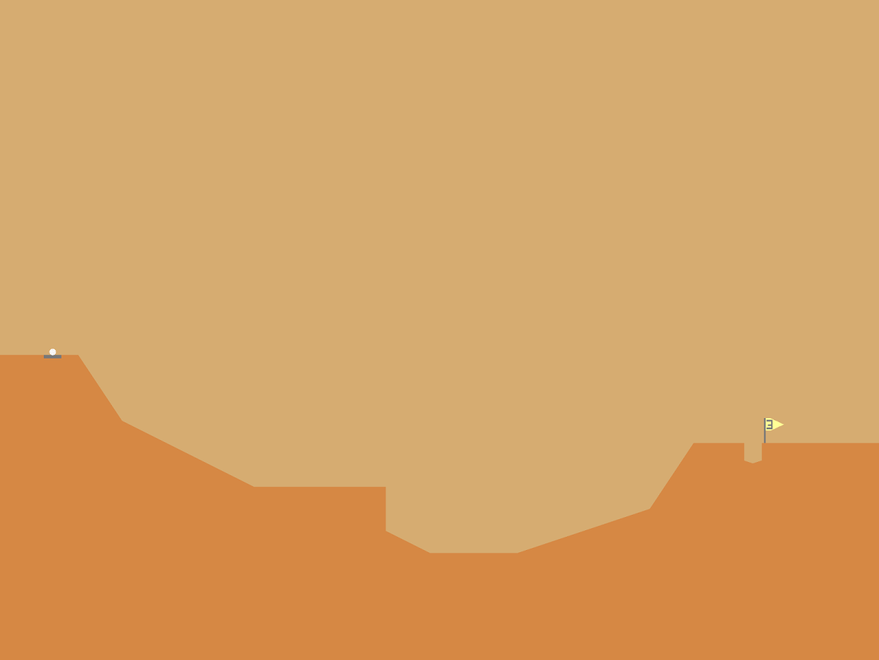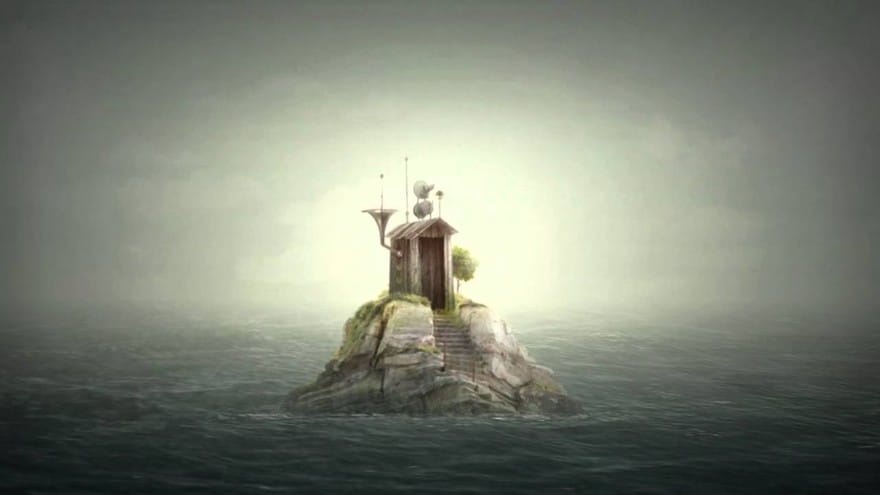The Year in Blank Space

Header image via David Calvo
///
Viewed from a particular angle, videogames can appear to be an ongoing arms race—the endless pursuit of more pixels, more processing power, more side-quests, more customization, more collectibles, more frames per second. There is, however, another side to things, and in recent years games that try to do less have received increasing attention. Games such as Dear Esther and Gone Home have offered a minimalist yin to the big-budget maximalist yang by focusing on atmospheric storytelling rather than action. In both games, the player is dropped into a particular location, designed and rendered in rich detail as an abandoned space, and the central task is for the player to populate the world not by completing challenges, collecting items, or defeating enemies, but by discovering and assembling in memory the history of the people who were once there. Much of this is accomplished through the world itself—eerie glowing caverns, typewriters, mixtapes, and hand-written notes, with explanations provided by voices triggered by the player’s movement through that world.
the emptiness of a digital space cannot be considered to be simply subtractive
This year, a number of games have built on those minimalist foundations by creating environments in which narrative is almost entirely absent, or where interactive elements decline to function as components of recognizable “gameplay.” These games are constructed as functionally empty spaces where neither story nor leveling up are really available to the player, and they may hint at the possibility of a sort of digital Abstract Expressionism where the player participates in enacting a virtual world without the benefit of familiar narrative and representational tools.
Space—in any media—is the result of the repetition of elements in time. Each inch of a digital hallway, for example, is the trace of an act of extension just as much as a brushstroke in a field of color on canvas. Given that virtual spaces are the products of active, ongoing generation—the result of code put into operation—the emptiness of a digital space cannot be considered to be simply subtractive. Desert Golfing, for example, might initially be described as Angry Birds without birds, pigs, music, color, or an ending. It is the ultimate in anti-narrative, an experience apparently without an ending, but anti-mechanistic to the same extent. There is, in a sense, no win state in Desert Golfing, just an eternal ongoing present. One can be winning in Desert Golfing, but only comparatively—a lower number of strokes for a certain number of holes, a greater number of holes completed. These measures must be assigned, however. They are not clearly given by the game, and there is no method of making these comparisons within the game itself. There are no leaderboards, no final scores. Each individual hole once completed is lost, subsumed into the overall count of the number of times the player has dragged her finger across the touchscreen.

As an interface, Desert Golfing is essentially an endless invisible line dividing two fields of lighter and darker brown, a white, roughly manipulable dot, and three markers which serve to create rather than record time. It’s a striking utilization of modern, ultra-high resolution mobile device screens, this perfect, borderless juxtaposition of glowing ecru and ochre, on and on into infinity.
This is color as assertion and expression, the distaff, illegitimate great-grandchild of Mark Rothko. By creating a space without resorting to the standard points of reference, Desert Golfing serves as an almost subliminal meditation on how a digital space can be recognizably populated, a demonstration that a mechanic can exist with a frame rather than a purpose. Desert Golfing, after all, isn’t golf any more than it is Angry Birds. It is existence in color and time, with just enough movement to avoid stasis, to be a thing in time rather than simply a thing.
This would appear to stand in contrast to Hohokum, a game whose spaces explode with velocity and vivacity. The world of Hohokum is filled with representational objects—pots and lamps, tubes and pipes, water and stars, plants and animals. There are even people of all shapes and sizes, who may not be recognizably human, per se, but who have professions and desires, jobs and recreations. Hohokum is fairly teeming with virtual objects, but as a game space it is “empty” in a sense not entirely dissimilar from Desert Golfing.

Hohokum utilizes activity in the absence of a purposeful frame to drive the player to manipulate movement and color within a virtual space. It’s not entirely fair to say that Hohokum obscures its mechanics, but spending any length of time in Hohokum makes it painfully apparent how much energy many games expend in trying to explain themselves to the player. A standard reading of Hohokum’s lack of tutorial, and its determined failure to signal goals within its wildly divergent levels, would be that discovering the game’s goal is the goal of the game. However, the game itself is operationally indifferent as to whether players unlock hidden trophies, or even “complete” levels. Rather, players can move freely from stage to stage, discovering features and interactivity at will, some of which is rewarded with recognizable “progress”—a new character revealed, a brief cutscene, a new function revealed for an in-game object—but most of which seems to exist for its own sake: movement, sound, and color as their own reward.
Within the Abstract Expressionist analogy, Hohokum is to Jackson Pollock as Desert Golfing is to Rothko: fluid rather than stable, exploratory rather than assertive, but in both instances concerned with space rather than representation. And the expressiveness in question is more a matter of bringing into being rather than emotionalism. Discovery of all the specific game mechanics of Hohokum isn’t particularly necessary, and neither is it especially useful to insist on the game as a “pure” play experience. In either case, the player participates in enacting the game world. This is, of course, in no way unique to Hohokum. Every player enacts the game world in every game by accepting and operating within the game’s systems, whether those systems are narrative or mechanical. In Hohokum, those systems are suggestively empty—no particular story, the goals obscure and functionally unnecessary. And yet the game seems largely to work anyway. The world can be enacted even if it isn’t understood.
visionaries are carving out the space to explore the expressive possibilities of emptiness
Compared to Hohokum and Desert Golfing, The Sailor’s Dream would seem to be a much more traditionally recognizable narrative puzzle game, especially since many of the tools the game uses to create a play space have so much in common with Simogo’s earlier Year Walk. In both games, the player navigates what are essentially stacks of cards, two-dimensional scenes arranged as overlaid maps in order to suggest a three-dimensional world. The Sailor’s Dream adds a repetitive element between these stacks of cards in order to create an additional sense of scale within the world—an “ocean” which requires players to swipe the screen repeatedly in order to navigate between locations in the game—but it also reimagines the “puzzle” objects that populate the spaces in that world.
It is common for elements in puzzle games to acquire functionality only some time after they are first encountered. Players either must unlock the objects through other puzzles, or must find information that explains the object’s intended use. There is even a locked box whose solution is hidden outside the game, in a companion app. Opening this box reveals an alternate ending, allowing a character to reach across time and between texts to change the events of the game’s story. As players explore The Sailor’s Dream, however, the objects remain insistently obscure. A miniature orrery allows players to manipulate planets in their orbits, which emit a variety of musical tones as their paths intersect. A row of lamps can be lowered from the ceiling in a hallway, clicking as if driven by a spring mechanism as they return to their original height.

There are, however, no keys to be found inside the game or elsewhere, no hidden purpose to be discovered. As in Gone Home and Dear Esther, moving through space in The Sailor’s Dream reveals a story, but that story is incidental to the world, a thing that took place somewhere else, and that does not bear a clear and necessary connection to the objects in the world. This is, in part, a reflection of the tenuousness of the connections between the characters described in the story, a sailor and a woman, the sea, and a girl who is not their daughter. Sometimes, things don’t work. That’s life. But as a matter of narrative and game design, there’s something else at play.
There’s a narrative maxim known as Chekov’s gun that argues against the inclusion of extraneous elements. If a gun is described as hanging on the wall at the beginning of a story, then it must be fired by the end. In games, a similar principle often acts as a signal to players to guide their actions. The time and energy required to create interactive objects is so substantial that players can reasonably expect that anything that can be manipulated will serve a purpose in the game. The objects in The Sailor’s Dream, on the other hand, are ostentatiously empty. In effect, that emptiness itself actually serves to creates space. Objects in The Sailor’s Dream occupy a space in order for there to be a space to be occupied.
Because ultimately there is no such thing as absolutely empty space, especially when it comes to virtual worlds where every centimeter of length, width, and depth is composed of ones and zeroes repeated again and again. During most of the brief history of videogames, those spaces have been utilitarian. No matter how richly decorated, no matter how detailed the rendering, game spaces have been purposeful, full even to bursting with rule sets and operations, stories and significance. We’ve been opening those spaces up in the past few years with minigames, sandbox environments, and almost archaeological embedded narratives. The race to build the biggest, fullest games will continue, but a handful of visionaries are carving out the space to explore the expressive possibilities of emptiness. It’s a luxury we may finally be able to afford.



